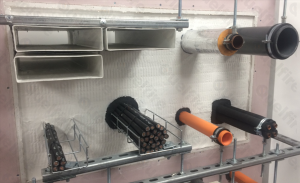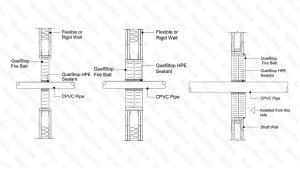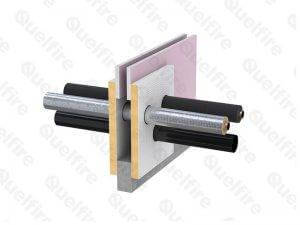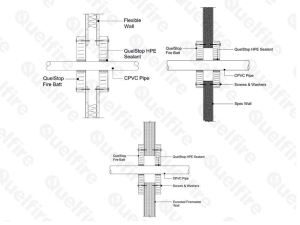Pattress vs. letterbox installation of QuelStop Fire Batt? Firestopping FAQs
QuelStop Fire Batt can be installed in a variety of ways. However, the most common method would be to install it into a formed opening, otherwise known as a ‘letterbox opening’ or a Builders Work in Connection (BWIC) opening, as shown in the example below:


Depending on the chosen service penetration detail, QuelStop Fire Batt will either be installed as a single or double layer and will need to be fitted tight within the aperture, in accordance with the installation instructions.
Another type of installation for fire batt is what is known as ‘pattress fixing’. This is where the QuelStop Fire Batt is positioned on the face of the fire-separating element and fixed to the substrate in accordance with the installation instructions. These will define the required fixings and minimum overlap.
An example of a pattress application:


The choice of installation will be determined by a variety of factors that can include:
- Fire-resistance requirements: There may be instances where a pattress application can provide a better fire-resistance rating than a friction-fitted fire batt detail and vice versa.
- Acoustic requirements: The larger the air gap between the QuelStop Fire Batts, the better the acoustic rating will be, meaning a pattress application may be a better selection.
- Aperture sizes: Typically, pattress applications have smaller aperture allowances.
- Access: Access may be limited, which will result in the possibility that a certain application can be used but not another.
- Installation: Some find it easier to pattress-fit fire batt due to space limitations or incorrectly formed openings, whereas others prefer to friction-fit due to the possibility of using fewer materials and no mechanical fixings.
Watch the video:
As always, when it comes to passive fire protection for service penetrations, the key is to ensure the solution you use is the correct one covered by fire test evidence. If you are unsure about what detail to use, don’t hesitate to get in touch at technical@quelfire.co.uk.

